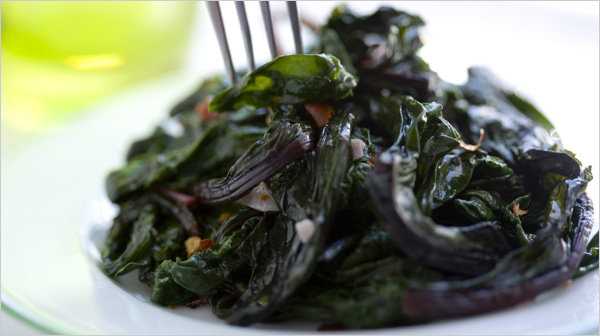







Beet leaves, also known as beet greens, are the leafy tops of the beetroot plant. They are often overlooked and discarded, but they are actually incredibly nutritious and delicious. Many people don’t realize that beet leaves are edible and can be cooked in a variety of ways.
Beet leaves are packed with vitamins, minerals, and antioxidants, making them a healthy addition to any meal. They are a good source of vitamin C, vitamin K, iron, and calcium. Eating beet leaves can help boost your immune system, support bone health, and improve digestion.
When it comes to cooking beet leaves, there are many options to choose from. You can simply sauté them in olive oil with some garlic and onions for a quick and tasty side dish. You can also add them to soups, stews, or stir-fries for added flavor and nutrition. Another option is to steam or blanch beet leaves and use them as a filling for wraps or as a base for salads.
It’s important to note that beet leaves have a slightly bitter taste, similar to other leafy greens like spinach or kale. If you find the taste too strong, you can blanch the leaves before cooking to mellow out the bitterness. Additionally, you can pair beet leaves with ingredients that have a sweeter or tangier flavor to balance out the taste.
So the next time you buy beets, don’t throw away the leaves! Give beet leaves a try and discover a new and nutritious addition to your meals. Whether you sauté, steam, or use them in soups and salads, cooking beet leaves is a great way to make the most out of this often overlooked part of the vegetable.
Delicious and Nutritious: Cooking Beet Leaves
Beet leaves, also known as beet greens, are the leafy tops of the beetroot plant that are usually discarded or used as animal feed. However, these vibrant and nutritious leaves are not only edible, but also delicious when cooked properly.
Health Benefits
Beet leaves are packed with essential nutrients and offer a wide range of health benefits. They are an excellent source of vitamins A, C, and K, as well as minerals such as iron, calcium, and potassium. Additionally, they are rich in dietary fiber, antioxidants, and phytonutrients, which have been linked to various health benefits including improved digestion, immune support, and reduced risk of chronic diseases.
Cooking Methods
When it comes to cooking beet leaves, there are several delicious methods to choose from:
- Sautéed: Sautéing beet leaves with garlic and olive oil is a simple and tasty way to enjoy them. Heat some olive oil in a pan, add minced garlic, and sauté until fragrant. Then, add the beet leaves and cook until wilted. Season with salt, pepper, and lemon juice for added flavor.
- Steamed: Steaming beet leaves helps retain their vibrant color and nutrients. Simply place the leaves in a steamer basket over boiling water and steam for a few minutes until tender. Serve as a side dish or incorporate them into salads and soups.
- Stir-fried: Stir-frying beet leaves with other vegetables and proteins makes for a nutritious and flavorful meal. Heat some oil in a wok or skillet, add your choice of vegetables, proteins, and beet leaves. Stir-fry until cooked through and season with soy sauce, ginger, and garlic.
Remember to remove the tough stems before cooking, as they can be fibrous and unpleasant to eat. You can easily do this by folding the leaf in half and slicing along the stem. Additionally, be sure to wash the leaves thoroughly before cooking to remove any dirt or grit.
By incorporating beet leaves into your meals, you can add a burst of color, flavor, and nutrition to your diet. Whether sautéed, steamed, or stir-fried, these versatile greens are sure to delight your taste buds and provide you with a range of health benefits.
Explore the Versatility of Beet Leaves

Beet leaves, also known as beet greens, are often overlooked when it comes to cooking with beets. However, these vibrant and nutrient-packed greens are incredibly versatile and can be used in a variety of delicious dishes.
One popular way to enjoy beet leaves is by sautéing them. Simply heat a bit of olive oil in a pan, add the leaves, and cook until they are wilted and tender. You can season them with salt, pepper, and a dash of lemon juice for added flavor.
Another option is to use beet leaves in salads. Their slightly bitter taste pairs well with sweet and tangy dressings. Combine them with other leafy greens, fruits, nuts, and cheese to create a refreshing and vibrant salad.
For those who enjoy smoothies, beet leaves can be a great addition. They are rich in vitamins A, C, and K, as well as fiber, making them a healthy choice for your morning beverage. Simply blend them with your favorite fruits and a bit of liquid, such as almond milk or water, for a nutritious and energizing smoothie.
In addition to these options, beet leaves can also be used in soups, stir-fries, and even as a substitute for spinach in recipes. Their slightly earthy flavor adds depth to dishes and their vibrant color can make any dish visually appealing.
When cooking with beet leaves, it’s important to wash them thoroughly and remove any tough stems. You can use both the leaves and stems in your dishes, but keep in mind that the stems will take longer to cook, so you may want to separate them and cook them separately.
Next time you find yourself with a bunch of beets, don’t toss the leaves! Instead, explore the versatility of beet leaves and incorporate them into your meals for a nutritious and delicious twist.
Health Benefits of Beet Leaves
1. Nutrient-Rich: Beet leaves are a great source of essential nutrients. They are packed with vitamins A, C, and K, as well as minerals such as potassium, magnesium, and iron. Including beet leaves in your diet can help fulfill your body’s nutritional needs.
2. Antioxidant Properties: Beet leaves are rich in antioxidants, which help protect your body against oxidative stress and damage caused by free radicals. Antioxidants also contribute to reducing the risk of chronic diseases, such as heart disease and certain types of cancer.
3. Anti-Inflammatory Effects: Studies have shown that beet leaves possess anti-inflammatory properties. Including them in your diet may help reduce inflammation, which is associated with various chronic conditions, including arthritis and cardiovascular diseases.
4. Digestive Health: Beet leaves are a good source of dietary fiber, which plays a crucial role in maintaining a healthy digestive system. Consuming fiber-rich foods like beet leaves can improve digestion, prevent constipation, and promote overall gut health.
5. Weight Management: Including beet leaves in your diet can be beneficial for weight management. These leaves are low in calories and high in fiber, which can help you feel fuller for longer and prevent overeating.
6. Brain Health: Beet leaves are rich in nitrates, which are converted into nitric oxide in the body. Nitric oxide improves blood flow and oxygen supply to the brain, which can enhance cognitive function and reduce the risk of age-related cognitive decline.
7. Eye Health: The presence of vitamin A in beet leaves contributes to good eye health. It helps maintain the health of the retina and improves night vision, reducing the risk of conditions like macular degeneration and cataracts.
8. Bone Health: Beet leaves contain essential minerals like calcium and magnesium, which are crucial for maintaining healthy bones. Including these leaves in your diet can help prevent osteoporosis and promote strong bone density.
9. Heart Health: Beet leaves are rich in potassium, which plays a vital role in keeping your heart healthy. Potassium helps regulate blood pressure, reduces the risk of stroke, and improves overall cardiovascular function.
10. Detoxification: Beet leaves support the body’s natural detoxification process. They contain compounds that help cleanse the liver and aid in the elimination of toxins from the body.
Overall, incorporating beet leaves into your diet can provide numerous health benefits and contribute to your overall well-being. Remember to cook them properly to retain their nutritional value and enjoy their delicious taste.
Simple and Tasty Recipes for Beet Leaves
If you have beet leaves and you’re wondering what to do with them, we’ve got you covered! Here are some simple and tasty recipes that will help you make the most of these nutrient-packed greens.
1. Beet Leaf Salad
One of the easiest ways to enjoy beet leaves is by making a salad. Start by washing the leaves thoroughly and removing the tough stalks. Tear the leaves into bite-sized pieces and place them in a bowl. Add diced tomatoes, cucumbers, and red onions for freshness. Drizzle some olive oil and lemon juice over the salad and season with salt and pepper. Toss everything together and your refreshing beet leaf salad is ready to be enjoyed.
2. Stuffed Beet Leaves

If you’re looking for a more substantial meal, try making stuffed beet leaves. Blanch the leaves in boiling water for a few minutes until they become tender. In the meantime, prepare the filling by combining cooked rice, ground meat (such as beef or lamb), diced onions, garlic, and spices of your choice. Place a spoonful of the filling onto each leaf and roll them up, tucking in the sides to seal. Arrange the rolls in a baking dish, pour some broth or tomato sauce over them, and bake in the oven until cooked through. Serve hot with a dollop of yogurt on top.
3. Beet Leaf Pesto
For a twist on traditional pesto, make beet leaf pesto. Blend beet leaves, garlic, parmesan cheese, pine nuts, and olive oil together until smooth. Season with salt and pepper to taste. This vibrant pesto can be used as a spread for sandwiches or as a sauce for pasta. It adds a unique flavor and a beautiful hue to your dishes.
So don’t let those beet leaves go to waste. Give these recipes a try and discover how delicious beet leaves can be!
Questions and answers
Can I cook beet leaves?
Yes, you can. Beet leaves are edible and can be cooked in a variety of ways.
What are some ways to cook beet leaves?
There are several ways to cook beet leaves. You can sauté them with garlic and olive oil, boil them and use them in soups or stews, or even grill or roast them.
Are beet leaves nutritious?
Yes, beet leaves are highly nutritious. They are rich in vitamins A, C, and K, as well as minerals like iron, calcium, and magnesium.
How should I prepare beet leaves before cooking?
Before cooking, you should remove the stems from the leaves and wash them thoroughly. You can then chop or tear the leaves into smaller pieces, depending on your preference.
Can I use beet leaves in salads?
Yes, you can. Beet leaves can be used raw in salads. Just be sure to wash them well and remove any tough stems before adding them to your salad.
Can you cook beet leaves?
Yes, you can cook beet leaves. They are edible and can be used in a variety of dishes.






